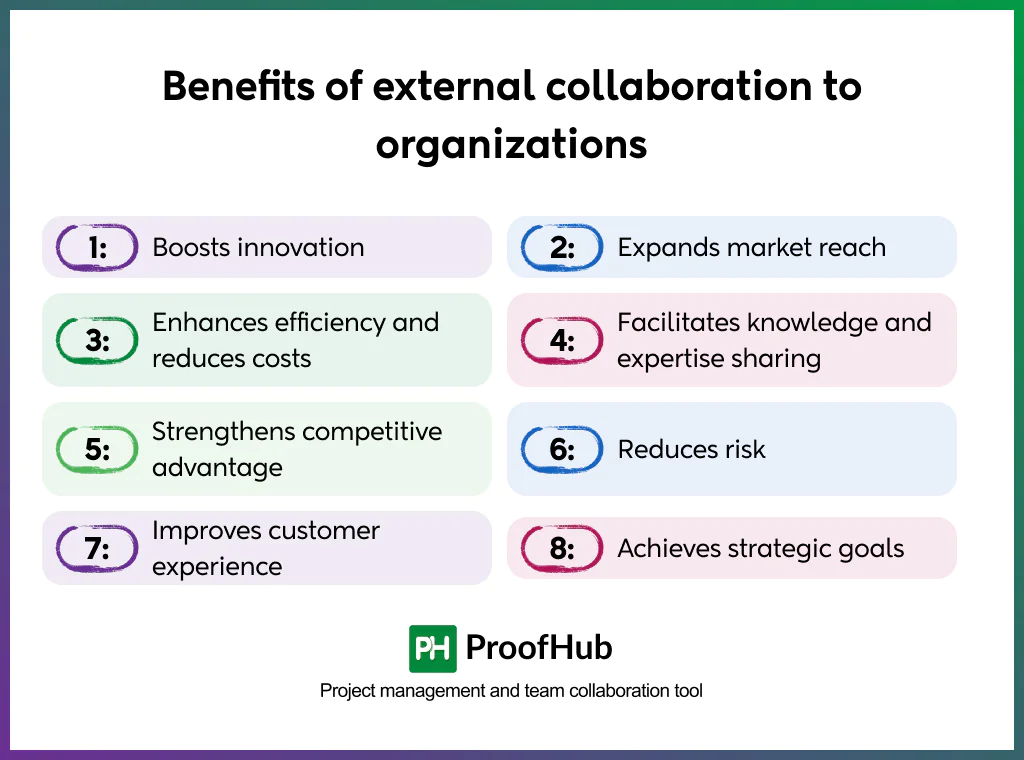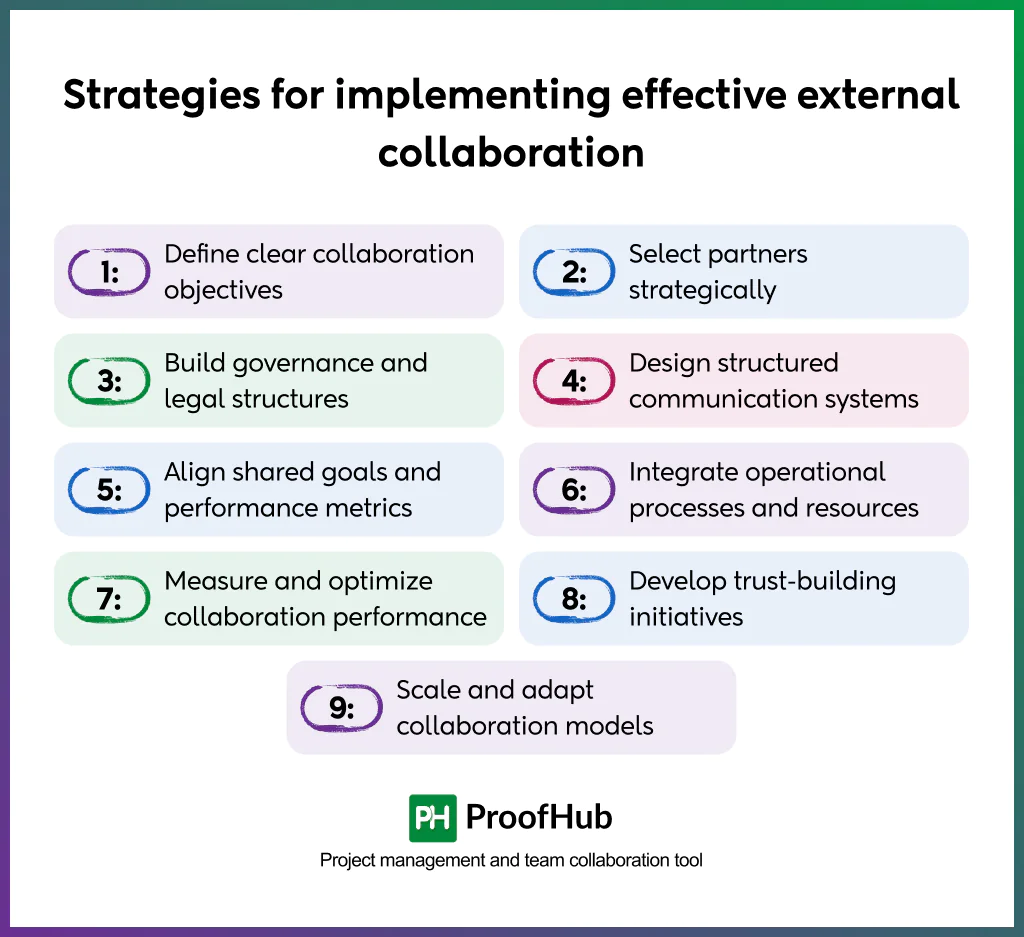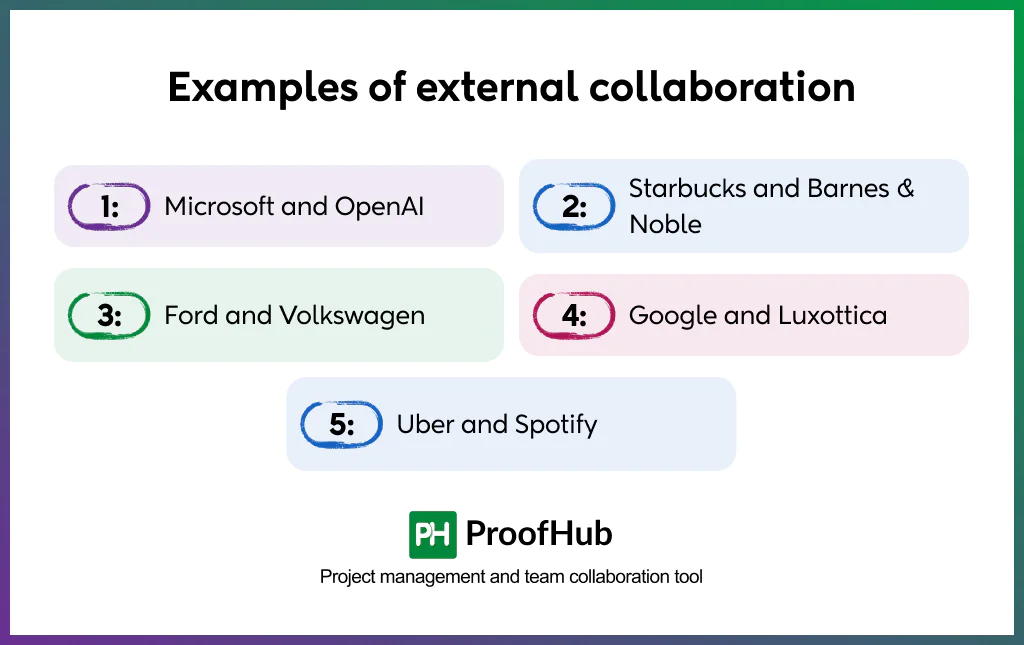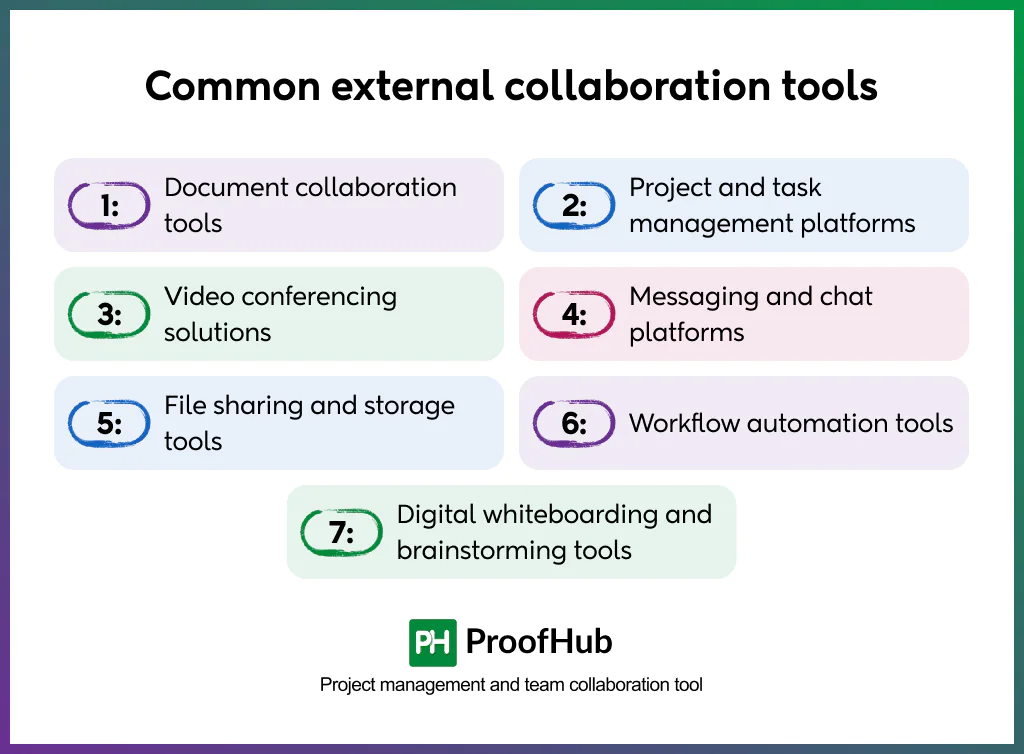
External collaboration is the process of organizations working with outside partners, such as clients, suppliers, contractors, distributors, research institutions, or even competitors, to achieve shared goals through resource alignment, knowledge exchange, and joint execution.
External partnerships provide access to specialized expertise, advanced technologies, and broader networks, reducing costs, accelerating innovation, diversifying supply chains, and strengthening long-term resilience.
Effective external collaboration requires clear objectives, selected partners with aligned goals, established governance frameworks, standardized communication, and trust for success.
In this article, we discuss what external collaboration is, its benefits, strategies for effective implementation, common challenges, and how to overcome them, along with real-world examples and tools that enable external collaboration.
What is external collaboration?
External collaboration is a process of organizations working with individuals or groups outside their corporate boundaries to achieve shared goals through knowledge exchange, resource alignment, and joint execution.
It involves formal partnerships with vendors, contractors, clients, and industry peers. External collaborations bridge organizational boundaries to create extended networks of value.
Effective external collaboration requires structured communication, clear role definitions, and the use of digital collaboration tools to overcome geographical, cultural, and organizational differences. This approach ensures efficiency and builds long-term trust with external stakeholders.
Why are external collaborations important?
External collaborations help organizations maintain competitiveness, innovation, and efficiency with external resources. It gives managers access to expertise, technology, and capacity without building them internally, reducing fixed costs, improving scalability, and enabling faster delivery of products and services.
It drives innovation by introducing external knowledge and diverse perspectives. According to the study “Collaboration with External Organizations and Technological Innovations: Evidence from Spanish Manufacturing Firms”, conducted by Dragana Radicic and Jonathan Pinto in 2019, collaboration with customers, suppliers, competitors, and Higher Education Institutions (HEIs) significantly improved product and process innovation.
External collaboration also reduces risks by diversifying supply chains and avoiding operational bottlenecks. Managers depend on external stakeholders to address specialized research, regulatory requirements, and market expansion, making collaboration essential for long-term stability.
What are the benefits of external collaboration to organizations?
External collaboration benefits organizations by boosting innovation, expanding market reach, reducing costs, and strengthening competitive advantage through external expertise, technology, and networks.

Here is how external collaboration drives organizational success:
- Boosts innovation: Collaboration with external stakeholders provides access to new ideas, research, and technologies. Diverse perspectives generate better solutions and accelerate adaptation to market changes.
- According to a study titled “Enhancing Innovation Performance through Business Process Innovation: The Strategic Role of External Collaboration” conducted by Gun Jea Yu, Joonkyum Lee, and Bumsoo Kim in 2024, collaboration with external firms provides valuable external knowledge, which, when combined with internal process innovations, results in better innovation outcomes.
- Expands market reach: External collaboration builds partnerships with distributors, vendors, or clients, enabling entry into new markets, increasing brand visibility, and enhancing customer trust.
- Enhances efficiency and reduces costs: Working with partners improves efficiency and reduces costs through shared use of resources, lower fixed expenses, streamlined operations, and faster delivery cycles.
- Facilitates knowledge and expertise sharing: External experts provide knowledge and specialized skills that are not available internally, enabling continuous learning and capability development within the organization.
- Strengthens competitive advantage: Joint efforts with suppliers, clients, or contractors provide a competitive advantage by improving an organization’s ability to respond to a market shift with more agility and resilience.
- Reduces risk: External collaboration reduces risk through diversified supply chains and shared responsibilities, which minimizes dependency on single sources and prevents operational disruptions.
- Improves customer experience: Co-creation with clients and partners enhances customer experience by providing better product quality, customization, and service delivery.
- Achieves strategic goals: Strategic alliances built on aligned goals, trust, and strong governance help organizations achieve long-term objectives such as innovation leadership, sustainability, and international expansion.
Strategies for implementing effective external collaboration
To implement external collaboration effectively, define clear objectives, choose the right partners, establish governance, standardize communication, align performance metrics, integrate processes, and build trust.

The following are the key strategies for implementing external collaboration effectively:
- Define clear collaboration objectives
Defining collaboration objectives clearly keeps partnerships focused and prevents wasted resources. When goals are precise, both sides understand why the partnership exists and what outcomes to expect, making it easier to evaluate success.
To achieve this, set measurable goals such as innovation outcomes, cost reduction, or market expansion. Use tools like OKRs, project charters, or balanced scorecards to map responsibilities and track ownership. Regular reviews ensure priorities stay aligned as conditions change.
- Select partners strategically
Choosing partners who align with strategic needs ensures external strengths complement internal needs. A well-matched partner contributes expertise, reliability, and stability that amplify collaboration outcomes.
Conduct due diligence using financial health checks, case studies, and reference validation before committing. Involving cross-functional managers in partner evaluation avoids blind spots, making decisions balanced and resilient.
- Build governance and legal structures
Establishing governance and legal structures early protects collaborations from conflict and uncertainty. Clear frameworks prevent disputes, streamline decision-making, and allow organizations to focus on results instead of resolving disagreements. A study titled “Regulating Collaboration: The Legal Framework of Collaborative Governance in Ten European Countries” by Agnes Batory and Sara Svensson in 2019 revealed that well-defined legal frameworks are essential in regulating external collaboration, as they provide stability, ensure compliance, and reduce risks of conflict.
Create agreements that cover roles, responsibilities, intellectual property rights, and compliance obligations. Governance models with escalation procedures and predefined authority reduce bottlenecks, while early legal involvement prevents costly revisions later.
- Design structured communication systems
Structured communication systems eliminate delays and ensure accountability across all stakeholders. Transparent communication keeps projects on track and prevents information from being lost across fragmented channels.
Use centralized platforms where documents, discussions, and approvals remain accessible to all partners. Setting regular meeting schedules and escalation paths ensures urgent issues are addressed quickly, building trust through consistency.
- Align shared goals and performance metrics
Aligning shared goals with clear performance metrics keeps collaborations transparent, consistent, and performance-driven. When all parties evaluate success the same way, external collaboration becomes easier to manage and improve.
Convert broad objectives into measurable KPIs such as delivery speed, cost savings, or product launches. Standardize reporting formats and review cycles to ensure comparability. Involve both internal and external stakeholders when setting metrics to build ownership and accountability.
- Integrate operational processes and resources
Integrating operational processes and resources streamlines execution and prevents duplication of effort. Seamless integration accelerates delivery, reduces friction, and maximizes the use of available assets.
Adopt shared tools for project collaboration and management, workflow automation, and document collaboration to let partners work efficiently without risking data exposure. Map touchpoints between internal and external teams to avoid overlapping responsibilities and ensure smooth handoffs.
- Measure and optimize collaboration performance
Continuous measurement and optimization sustain efficiency and provide opportunities for improvement. Tracking external collaboration performance ensures minor issues don’t grow into systemic failures.
Use dashboards and regular performance reviews to track leading indicators such as cycle times and error rates. Feedback loops with external stakeholders provide additional insights, helping teams adapt quickly and maintain momentum.
- Develop trust-building initiatives
Trust built through transparency and fairness strengthens long-term relationships and reduces conflicts. Partnerships thrive when stakeholders feel respected, valued, and secure in their roles.
Build trust by sharing both successes and setbacks openly, recognizing contributions, and balancing risks and rewards fairly. Consistency in delivering on promises builds credibility over time, making it easier to navigate uncertainty together.
- Scale and adapt collaboration models
Scaling and adapting collaboration models ensures partnerships remain valuable as markets and priorities change. A flexible approach allows organizations to maximize gains from successful alliances while discarding those that no longer deliver value.
Review the performance of existing partnerships to identify which should be expanded, redesigned, or exited. Scale proven models across business units or regions to capture more value. Also, adapt to new regulations, technologies, or customer needs to keep collaborations competitive.
What are the challenges of external collaboration?
The challenges of external collaboration include communication barriers, information silos, data security risks, conflicting goals, lack of trust, fragmented tools, and limited shared infrastructure.
Here are the most common challenges of external collaboration and how to address them effectively.
- Communication barriers: Different styles, time zones, and reporting formats across organizations create misalignment and rework, slowing approvals and decisions.
Address this challenge through a joint communication plan (schedules, channels, single points of contact), use of a shared workspace for updates, and consistent documentation of meetings.
- Information silos: Updates held by partners or organizations cause version conflicts, duplicate work, and missed dependencies.
Breaking silos requires a centralized platform with a shared repository where all collaborators can access, review, and update information, ensuring transparency and preventing overlooked changes. Hold regular cross-company review meetings to manage risks and maintain alignment.
- Data security risks: Collaborators often share files via email, shadow IT, or unsecured links; subcontractors get uncontrolled access; data ownership is unclear, resulting in leaks or compliance exposure.
Mitigate this challenge by storing and managing information in a single controlled environment with defined permissions, encrypted access, and proper audit trails, keeping stakeholders aligned and informed.
- Conflicting goals and priorities: Each party optimizes for its own targets (margin, speed, scope), creating scope creep, budget overruns, and missed milestones.
Align collaborators by setting shared OKRs and metrics, a clear RACI model, creating a structured change-control process, and forming an arbitration committee for trade-offs.
- Lack of trust: Opaque status, missed commitments, and defensive behavior due to lack of trust result in withheld information and padded estimates.
To build trust, use centralized platforms, run joint retrospectives, tie payments to observable milestones, and publish transparent decision rationales.
- Fragmented tools and interoperability issues: Partners use incompatible project management suites, file formats, or schemas, causing errors and delays.
Minimize it through standardizing on core platforms, integrating systems via APIs/EDI (Application Programming Interfaces/Electronic Data Interchanges), using a shared data dictionary, and validating integrations with test fixtures.
- Limited shared infrastructure: No shared environments, vendor portals, or secure sandboxes slow onboarding and handoffs.
To avoid this, provide shared cloud workspaces, sandbox environments, and secure exchange platforms with clear governance for access and uptime.
What are the examples of external collaboration?

Some examples of external collaboration include:
- Microsoft and OpenAI: Microsoft invested in OpenAI and integrated GPT-4 across Azure, Bing, and Microsoft 365 Copilot. This allowed Microsoft to embed advanced AI in its services, while OpenAI gained the resources it needed to grow.
- Starbucks and Barnes & Noble: Starbucks opened cafes inside Barnes & Noble bookstores. This makes the bookstore a more enjoyable place to spend time, which helps both companies sell more.
- Ford and Volkswagen: Ford and Volkswagen jointly invested in Argo AI for autonomous tech and shared Volkswagen’s MEB electric vehicle platform for new models. This alliance lowered R&D costs and sped up product rollout in competitive markets.
- Google and Luxottica: Google worked with Luxottica (parent of Ray-Ban and Oakley) to design Google Glass frames that combine style with functionality, giving Google design expertise and Luxottica access to wearable tech innovation.
- Uber and Spotify: Uber lets passengers link Spotify accounts and play their favorite playlists during rides. This improved the ride experience and gave Spotify a new way to reach people.
What tools enable external collaboration?
External collaboration is enabled by digital tools such as document collaboration, project management, video conferencing, messaging, file sharing, workflow automation, and digital whiteboarding platforms.

Here are some common external collaboration tools:
- Document collaboration tools
Document collaboration tools allow multiple partners to create, edit, and review documents, spreadsheets, or presentations in real time. They prevent version conflicts, reduce email threads, and give external stakeholders visibility into the latest updates.
- Project and task management platforms
Project and task management tools provide a centralized space where organizations can assign responsibilities, set deadlines, and track progress in real time. They help external collaborators understand dependencies, reduce duplicated efforts, and keep projects on track, ensuring everyone is aligned on scope, milestones, and ownership.
- Video conferencing solutions
Video conferencing tools create space for brainstorming, problem-solving, and relationship building. They reduce miscommunication by adding context through visual cues and make it easier to run workshops, status updates, or negotiations with external teams.
- Messaging and chat platforms
Messaging and chat apps enable quick, informal communication across organizations without relying on lengthy emails. External partners can set up dedicated channels or groups for projects, keeping discussions focused and searchable, improving response times, reducing bottlenecks, and making collaboration more agile.
- File sharing and storage tools
Secure cloud storage and file-sharing tools give collaborators access to large files, media assets, or reports. Instead of transferring files through unsecured email, shared repositories ensure data is stored centrally with clear access controls and permissions, reducing risks of duplication, loss, or unauthorized sharing.
- Workflow automation tools
Automation tools integrate processes across different organizations by connecting apps, syncing data, or automating approvals. They reduce manual errors, speed up repetitive tasks, and ensure updates flow seamlessly between teams using different systems.
- Digital whiteboarding and brainstorming tools
Digital whiteboards allow distributed teams to ideate, map workflows, and visualize processes together in real time. They replicate the benefits of in-person brainstorming sessions and encourage creative problem-solving among external collaborators.
Some widely-used external collaboration tools include:
- ProofHub: Combines project management, task tracking, and team collaboration in a single space for internal and external partners.
- Microsoft Teams: Integrates chat, video meetings, and file sharing to streamline real-time communication across organizations.
- Zoom: Provides reliable video conferencing for external workshops, training sessions, and negotiations.
- Google Workspace: Offers real-time document, sheet, and presentation collaboration with secure file sharing.
- Dropbox: Provides centralized file storage and sharing with controlled access for external stakeholders.
What is the difference between external and internal collaboration?
The main difference between external and internal collaboration lies in who participates and how the collaboration is managed.
- Internal collaboration happens within an organization. Teams, departments, or individuals work together to achieve common business goals. It relies on shared systems, company culture, and internal governance. For instance, marketing and product teams aligning on a new launch is internal collaboration.
- External collaboration involves working with stakeholders outside the organization, such as suppliers, customers, contractors, competitors, or research institutions. It requires formal agreements, data-sharing policies, and structured governance to handle differences in goals, systems, and trust levels. For example, a company partnering with a university for R&D or with another brand for a joint venture.
What are the further types of external collaboration?
The further types of external collaboration include working with suppliers, customers, competitors, research institutions, contractors, strategic partners, and public organizations.
Here is how these types of external collaboration serve different organizational needs:
- Supplier collaboration means working closely with vendors to share forecasts, improve quality, and secure reliable materials.
- Customer collaboration involves co-creating products or services with clients and integrating feedback to improve satisfaction.
- Competitor collaboration, or coopetition, allows rivals to cooperate on research, technology, or industry standards while competing commercially.
- Academic and research collaborations with universities give organizations access to advanced knowledge, innovation, and skilled talent.
- Contractor and freelancer collaboration provides flexible expertise for short-term or specialized projects without long-term costs.
- Joint ventures and strategic alliances combine resources and governance structures to expand into new markets or pursue long-term opportunities.
- Collaboration with non-profits or government agencies enhances compliance, corporate responsibility, and access to public programs or incentives.
What external collaborations should a business consider?
A business should consider external collaborations that align with its goals for innovation, efficiency, market growth, and long-term competitiveness.
Some common options include:
- Collaborating with suppliers improves quality control, reduces costs, and secures reliable materials.
- Involving customers in product or service design aligns offerings with real needs.
- Partnering with universities or labs provides access to advanced research and specialized talent.
- Businesses pool resources to expand into new markets or product lines.
- Working with public bodies supports compliance, access to incentives, and CSR (Corporate Social Responsibility) initiatives.
- Competitors cooperate on shared challenges such as R&D or industry standards while still competing commercially.
What are the risks of poor external collaboration?
Poor external collaboration creates risks that weaken performance instead of improving it. When partners withhold information or fail to document decisions, teams waste effort on duplicate work and miss valuable insights. This lack of transparency slows innovation and makes projects difficult to scale.
As coordination fails, processes fragment and tasks overlap, creating higher costs and wasting resources. Disputes over misaligned goals delay delivery and stretch budgets. Furthermore, sharing sensitive data through unsecured channels creates compliance violations and reputational damage.
Over time, these breakdowns undermine trust. Partners become defensive, communication turns opaque, and collaboration loses momentum. When that happens, opportunities pass to competitors who manage their partnerships better, innovate faster, and deliver more value to customers.
Can external collaboration improve organizational innovation?
Yes, external collaboration improves organizational innovation by providing access to new ideas, expertise, knowledge, and resources beyond a company’s internal capability. Working with research institutions, startups, or industry partners introduces diverse perspectives and accelerates problem-solving resulting in breakthrough innovations.
How to ensure data privacy in external collaboration?
Ensuring data privacy in external collaboration requires a combination of technical safeguards and clear governance policies.
Share sensitive files through secure portals or encrypted channels, with access limited on a least-privilege basis. Multi-factor authentication (MFA) and single sign-on (SSO) prevent unauthorized access, while regular audits verify that permissions remain accurate.
Legal agreements such as NDAs, Data Processing Agreements (DPAs), and GDPR-aligned clauses must define ownership, retention, and acceptable use of data. Organizations also need vendor risk assessments to confirm that all partners comply with recognized security standards such as ISO 27001 or SOC 2.






